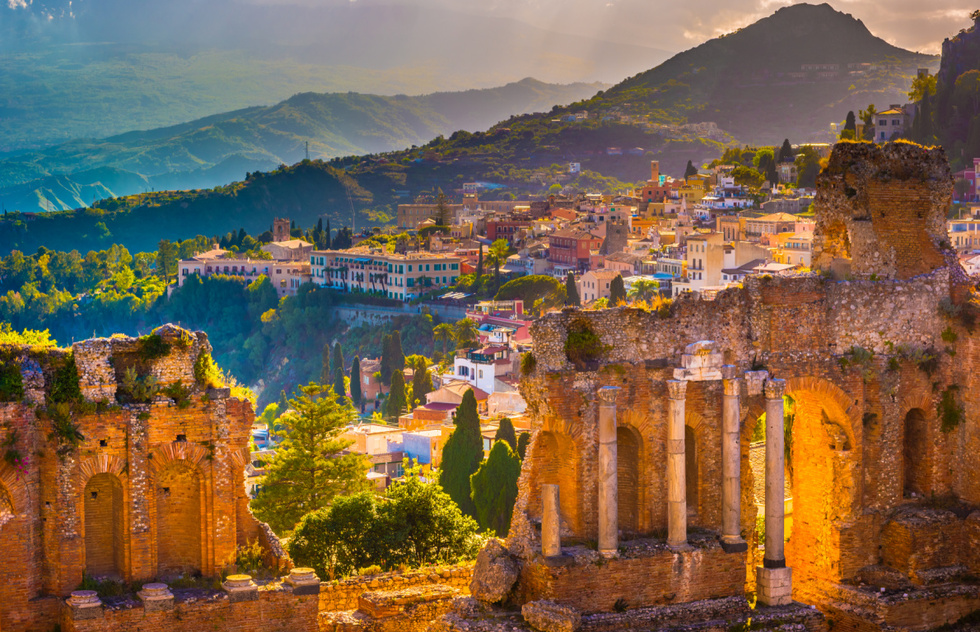Stirring landscapes, Greek ruins, great beaches, delicious street food, baroque towns, amazing art, decadent pastries—the Italian island of Sicily has just about everything you could want in a European vacation.
Here are 50 ways to enjoy it all.
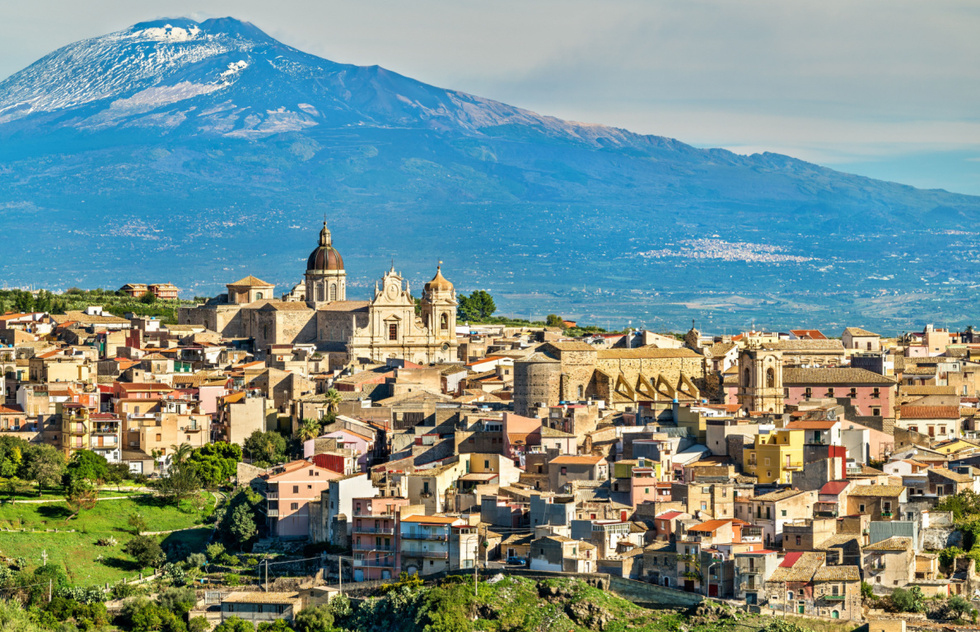 (Mount Etna overlooking Militello in Val di Catania in Sicily | Credit: Leonid Andronov / Shutterstock)
(Mount Etna overlooking Militello in Val di Catania in Sicily | Credit: Leonid Andronov / Shutterstock)
Natural Wonders
Ascend Mount Etna. The highest and most active volcano in Europe beckons despite smoking craters and smoldering lava flows. Whether you’re making the ascent on your own or signing on for a tour, the first leg is a ride on the Funivia dell’Etna cable car from Rifugio Sapienza to the Torre del Filosofo (Philosopher's Tower) terminus. Then it’s a steep hike or bumpy ride in a 4X4 vehicle across ashy terrain to the eerie crater area at about 9,800 feet.
Get salty at the Saline di Trapani. The shining white expanse of salt flats stretches for almost 2,500 acres on Sicily’s west coast and is home to flamingos, herons, and other migratory birds. Salt has been harvested here since antiquity, and you’ll learn all about this history at the Salt Museum. For instance, did you know the word “salary” comes from the Latin salaries, meaning “soldier's allowance for the purchase of salt”?
Set sail for Spiaggia Valle Muria. On the Aeolian island of Lipari, sheer cliffs back a hideaway beach washed by enticingly clear waters. You can hike there and back across the cacti-strewn landscape, but it’s easier taking one of the small boats operating out of Marina Corta.
Take a hike in Lo Zingaro. An 8.5-mile circuit trail skirts clifftops along the Monte Monaco headland at the island’s northwest tip, protected as a nature preserve. What’s there? Hillsides carpeted in wildflowers and Mediterranean maquis, beaches fringing crystal-clear coves, and soaring eagles. What’s not there? Motorized vehicles, towns, or many other signs of civilization.
Witness the volcano that never sleeps. The volcano of Stromboli, located on the same-named Aeolian island, has been blowing its top nonstop for millennia. You can witness the spectacle from a viewpoint overlooking the Sciara del Fuoco, a blackened wasteland created by explosions that occur with such regularity that ancient mariners set their course by the fiery glow, giving the island its nickname, “Lighthouse of the Mediterranean.”
Go bird-watching in Vendicari. This pristine nature preserve is the southernmost stop in Europe for a sky full of migrating flocks as they come and go from the wetlands of Tunisia. The snorkeling is terrific here, too, and hiking trails follow the unspoiled coastline for miles.
Take the plunge in the Egadi archipelago. A trio of little islands off the western coast are low-key getaways where a refreshing experience awaits: jumping into Sicily’s most pristine waters at Cala Rossa beach on Favignana, the largest of the three isles. Afterward, tuck into a simple meal of grilled, fresh-caught tuna at a portside osteria.
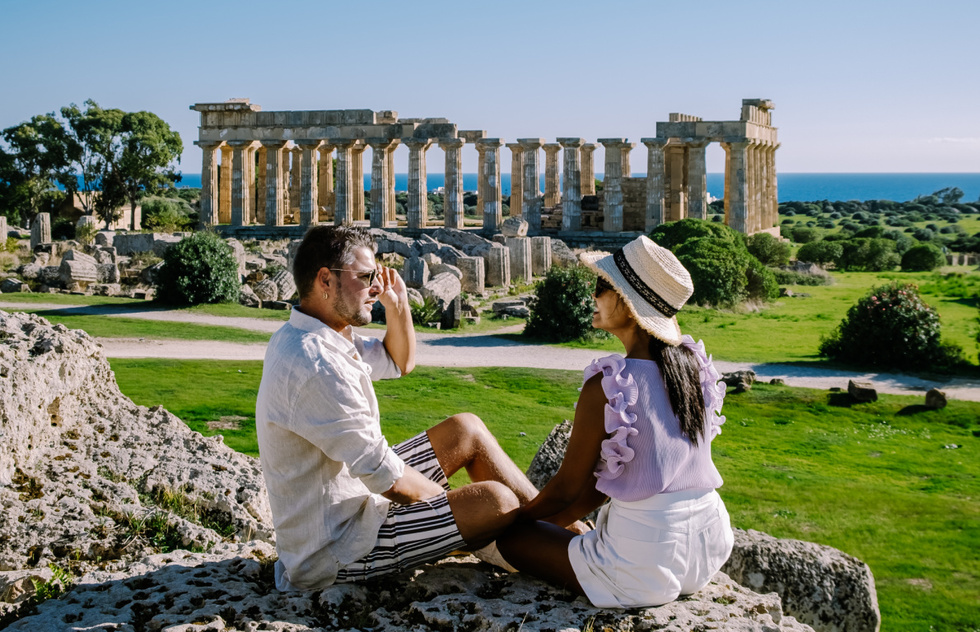 (Selinunte Archaeological Park in Sicily | Credit: fokke baarssen / Shutterstock)
(Selinunte Archaeological Park in Sicily | Credit: fokke baarssen / Shutterstock)
Classical Sicily
Explore the largest archaeological park in Europe. At Selinunte, the ruins of an ancient Greek city spread over 670 seaside acres in the island’s far southwest. The temples, streets of shops and houses, and town walls here were all abandoned more than 2,000 years ago. One of the few modern intrusions: an electric train providing a convenient way to cover the vast site.
Take a seat in a theater where Greek classics were first performed. Syracuse’s Teatro Greco was built in the 5th century BC and renovated by the Romans. The semicircular tiers of seats are still packed for summertime performances.
See one of the world’s oldest ships. Marsala’s seafront archaeological museum displays large sections of a 155-foot-long Roman craft launched during the Punic Wars in 241 BC. Sixty-eight oarsmen powered the sleek and speedy vessel.
Ogle a huge collection of Roman mosaics. Thirty-eight thousand square feet of rich mosaics carpet the many rooms of Villa Romana del Casale, a onetime hunting lodge outside Piazza Armerina. Delightful scenes depict mythology, flora and fauna, and domestic tableaux.
Pay homage to the Dancing Satyr. At the Museo del Satiro, a bronze statue from the 4th century BC captures the well-preserved head and torso of a young man-goat hybrid in a state of ecstatic frenzy, his arched back and tossed locks suggesting he’s frozen mid-jump. Dredged from the bottom of the sea in 1998, the satyr's current home is surrounded by domed towers, arched loggias, and a mazelike casbah in the transporting city of Mazara del Vallo.
Gaze upon the Temple of Segesta. This Doric beauty on a wildflower-carpeted hillside has been bewitching onlookers since it was built in the 5th century BC. Ancient workers never finished the job—the smooth columns, all still in place, were left unfluted and the roof is missing. Nevertheless, the site is thoroughly beguiling.
Relish the dramatic setting of Taormina’s Teatro Antico. The Greeks had a knack for building theaters in stunning locales, and they outdid themselves here. The backdrop of smoldering Mount Etna and the sea crashing far below just might upstage the performances at the amphitheater (pictured at the top of this page) in summer.
Appreciate the layers of time at Syracuse’s Duomo. The cathedral’s façade is a charmingly frothy baroque concoction, but tiers of columns around the entrance and lining the nave whisk you back to ancient Greece. The columns are what’s left of a 5th century BC Temple of Athena that stood on this site. Filled with gold and ivory, it was a draw for travelers from throughout the Mediterranean world.
Meet the Young Man of Mozia. Cast in marble around 440 BC, the Giovane di Mozia wears a clinging wet tunic and is the star of the show on his home island—once the Phoenician stronghold of Motya, now an archaeological park.
Follow myths in marble. At Palermo’s Museo Archeologico Regionale Antonino Salinas, a former convent is a treasure trove of the island’s long history. Most riveting are friezes from the Selinunte temples—Perseus slays Medusa, Actaeon is torn apart by hounds, and other action-packed myths unfold in the sensual marbles.
Listen for echoes in the Ear of Dionysius. A teardrop-shaped cavern burrowed into a hillside in Syracuse’s archaeological park amplifies even the faintest sounds. This acoustical phenomenon was handy for ancient ruler Dionysius I, who allegedly listened in on the whispered plots of prisoners chained within the cave’s damp reaches.
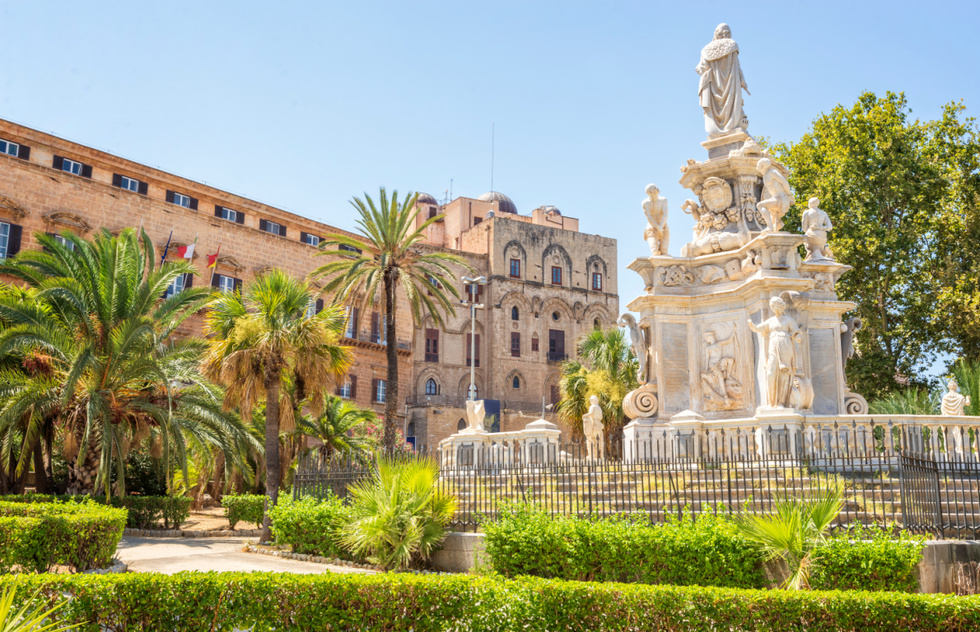 (Palazzo Reale in Palermo, Sicily | Credit: manasesistvan / Shutterstock)
(Palazzo Reale in Palermo, Sicily | Credit: manasesistvan / Shutterstock)
In and Around Palermo
Walk the halls of power at the Palazzo Reale. In the island’s capital city stands a regal residence that served as a fortress, royal palace, and seat of government for Sicily’s Arab, Norman, Bourbon, and Spanish rulers. The glittering jewel is the mosaic-covered Cappella Palatina, though the mazelike secret dungeons and a hall of winds (the 12th century’s answer to air-conditioning) are intriguing as well.
Marvel at the 12th-century Arab-Norman cathedral in Monreale. On a hilltop just outside the city, Byzantine craftsmen set to work covering every inch of this church’s interior with golden mosaics depicting 130 religious and biblical scenes. You’ll appreciate the old Sicilian saying, “Anyone who comes to Palermo without seeing Monreale arrives on a donkey and leaves as an ass.”
Stare death in the face at the Galleria Regionale della Sicilia. In the beautiful Palazzo Abatellis, a massive fresco called Trionfo della Morte (Triumph of Death) depicts the Grim Reaper as a fearsome skeletal demon astride an undernourished steed and brandishing a scythe as he leaps over his victims.
Guess who’s who in the Quattro Canti. Palermo’s two main streets, Via Maqueda and Corso Vittorio Emanuele, intersect with fanfare at the Quattro Canti, or Four Corners. Each quadrant is decorated with a three-tiered niche filled with statues representing the four seasons, Spanish Hapsburg kings, and the patron saints of the adjoining districts.
Ooh and ahh at saintly sculptures. Some of Palermo’s most exuberant places of worship are the private chapels that the 18th-century artist Giacomo Serpotta decorated in sculpted stucco. His pièce de résistance is the Oratorio di San Lorenzo, called “a cave of white coral” for the artist’s lavish depictions of the namesake saint being roasted on a spit and undergoing other religious ecstasies. What’s not here anymore is the last large painting by Caravaggio—the work was stolen in 1969 and never recovered in one of the world’s great unsolved art heists.
Watch your step at the Teatro Massimo. Legend has it that a nun whose convent was displaced to build Italy’s largest opera house trips theatergoers as they ascend the staircase. Once safely seated, you’ll be treated to near-perfect acoustics, or, if you’re not around for a performance, you can see the beautiful neoclassical hall on guided tours.
Get spooked at the Catacombe dei Cappuccini. Some 8,000 souls, dressed in their Sunday best and in various stages of preservation, hang from hooks and recline in coffins at these catacombs.
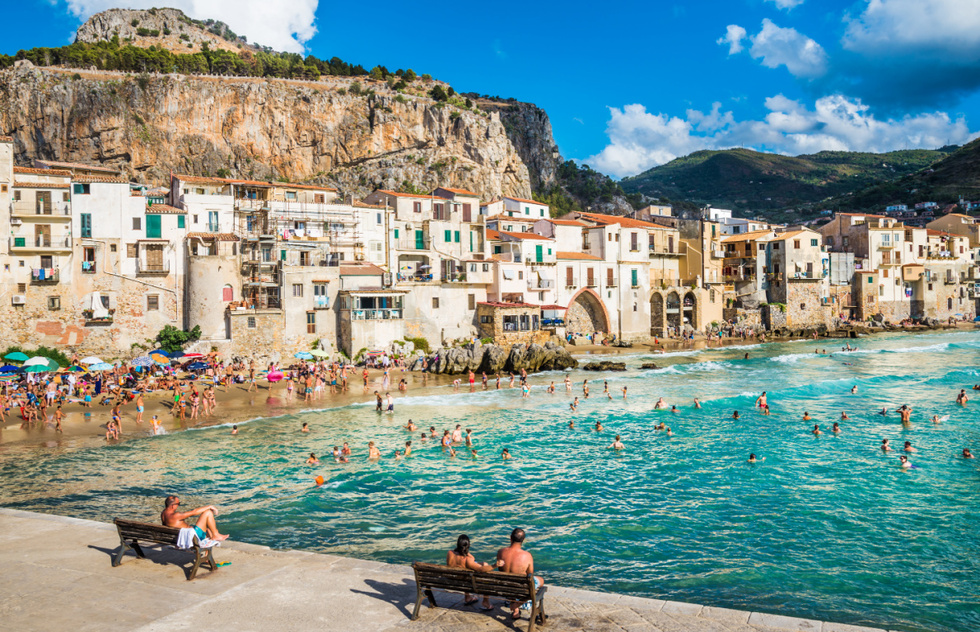 (Cefalù, Sicily | Credit: leonori / Shutterstock)
(Cefalù, Sicily | Credit: leonori / Shutterstock)
Enchanting Towns Around the Island
Gasp at the view over Ragusa Ibla. This picturesque assemblage of domes, tile roofs, and baroque facades straddling a ridge between two deep gorges is best appreciated from on high—especially from the church of Santa Maria delle Scale at the top of 340 steps linking the old and new towns.
Survey the west coast from Erice. The lofty medieval town, perched high atop Monte San Giuliano and reached by winding mountain road or cable car, overlooks much of western Sicily, with the Mediterranean sparkling on the horizon. The ethereal outlook is best from the cliffside Giardino del Balio park. It’s little wonder the Romans claimed the site for a long-gone temple to Venus, goddess of love.
Savor the good life in Taormina. The fabled seaside resort is known for pampering celebrities, bon vivants, and other privileged visitors—as chronicled in the second season of HBO’s The White Lotus, shot at Taormina's opulent San Domenico Palace. For a shady refuge from worldly concerns, retreat to the lush gardens of the Villa Comunale. Laced with fanciful stone pavilions, the park has sublime views of the coast and Mount Etna.
Discover the charms of Cefalù. This fishing port turned beach resort has more to offer than a long strip of golden sand. An enchanting old town centers on a magnificent, mosaic-filled Duomo and is backed by La Rocca, a craggy summit that rewards a climb with views that on a clear day extend all the way to the Aeolian Islands.
Climb the tiled stairs in Caltagirone. This southeastern town shows off a long tradition of pottery-making on the Scalinata di Santa Maria del Monte, on which each of the 142 steps is tiled in colorful ceramics of a different style. Try to show up around July 26, when the stairs are lit with thousands of votive candles arranged in beautiful designs in honor of the town’s patron, San Giacomo.
Go for baroque in Noto. This stage set of honey-colored limestone features curved facades, curling staircases, and wrought-iron balconies decorating palaces and churches. The town becomes especially radiant at sunset, creating a spectacular setting for an evening passeggiata.
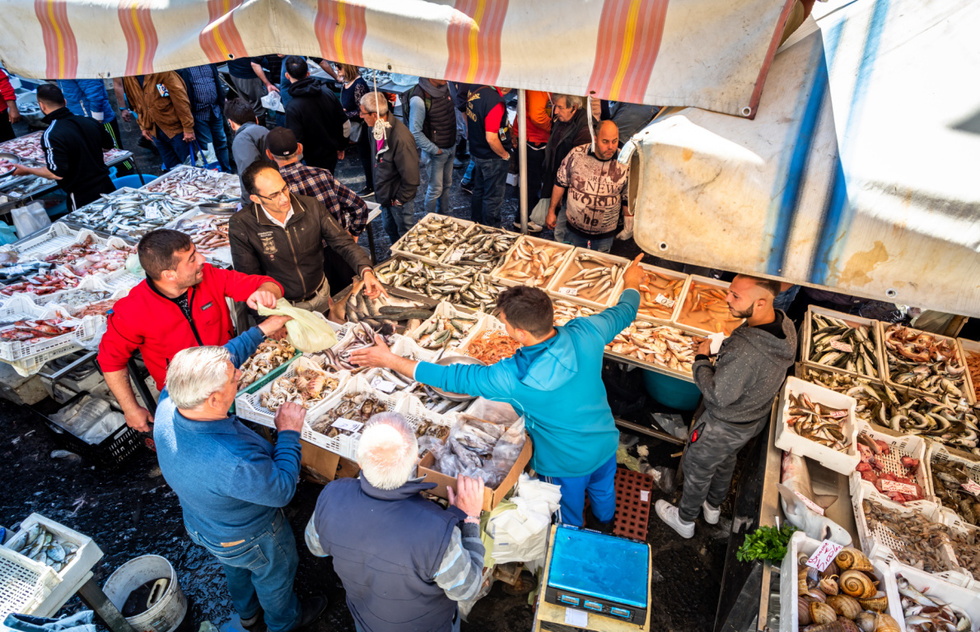 (La Pescheria fish market in Catania, Sicily | Credit: javarman / Shutterstock)
(La Pescheria fish market in Catania, Sicily | Credit: javarman / Shutterstock)
Enticing Street Food
Sample some spleen. A need-to-try-it-once Palermo favorite is pani câ meusa—a bread roll stuffed with slices of boiled veal spleen and melted cheese. Grab one at the sidewalk takeout window at 'Nni Franco U’ Vastiddaru on Piazza Marina.
Poke around La Pescheria. Stalls at Catania’s morning fish market are piled high with swordfish, tuna, sardines, squid, and other denizens of the deep. When you tire of the jostling shoppers and the shouts of cleaver-wielding fishmongers, take a seat and tuck into a seafood feast in the relative calm of the marketplace’s Osteria Antica Marina.
Make an arancini stop at Sfrigola. This is Palermo’s number-one spot for the island’s beloved saffron-flavored, stuffed rice balls that are rolled in bread crumbs and fried. By tradition these delicacies are filled with meat ragu and mozzarella, but Sfrigola mixes up the options with a wide choice of vegetables, cheeses, meats, and even tuna.
Shop and gawk in Palermo’s street markets. With stalls extending for blocks, the clamorous, age-old Ballarò and Capo markets recall Middle Eastern bazaars combined with juiced-up Italian food shops. The fresh produce, piles of fish, garlands of sausages, vats of olives, and other wares are all tempting, but especially fulfilling is the taste of Sicilian life.
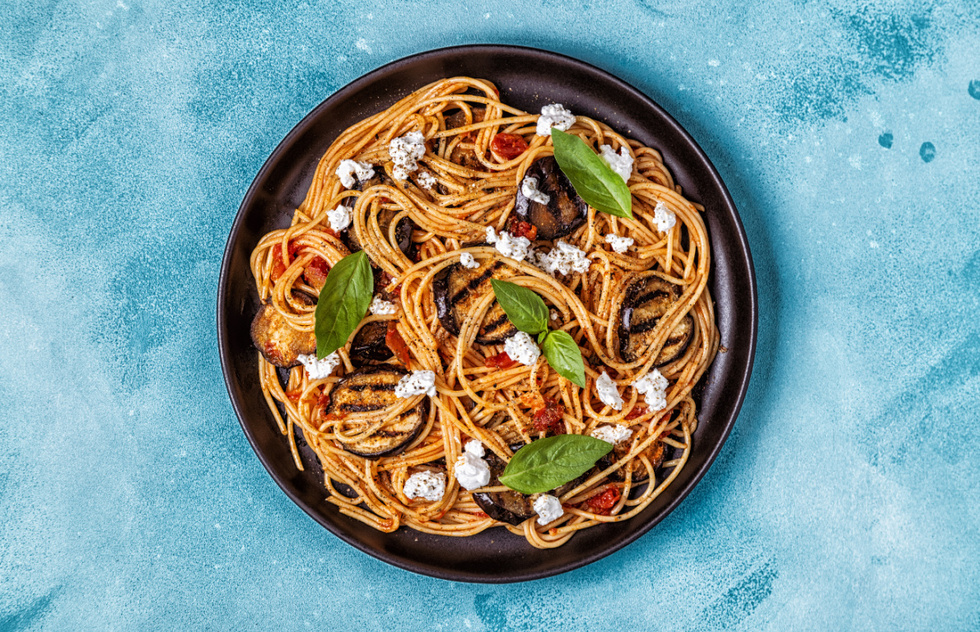 (Pasta alla Norma | Credit: Tatiana Bralnina / Shutterstock)
(Pasta alla Norma | Credit: Tatiana Bralnina / Shutterstock)
Unforgettable Sit-Down Meals
Hit the high notes with pasta alla Norma. Catania’s famous and delicious concoction of spaghetti, tomatoes, fried eggplant, and salted ricotta is named for the eponymous heroine of the opera by native son Vincenzo Bellini. Try a plateful at the modest but venerable Nuova Trattoria del Forestiero.
Cook with a duchess. During this culinary experience in Palermo, you’ll start the day on a market expedition with the charismatic Nicoletta Polo, Duchess of Palma. Then return to her brightly tiled palace kitchen to prepare a feast that’s served by white-gloved waiters in the duchess’s stately dining room.
Try Trapani’s take on couscous. A classic couscous alla trapanese is a flavorful concoction of fish, broth, tomatoes, and spices, baked in a terra-cotta pot and often topped with shrimp and mussels. Try some at Trapani’s summertime Stragusto food festival or any time of the year at old-world favorite Cantina Siciliana.
Dine on nouveau Sicilian cuisine at L’Ottava Nota. In Palermo’s exciting Kalsa quarter, this restaurant’s sleek, black-on-gray decor is the setting for creative takes on Sicilian classics—tuna tartare served with avocado, risotto-laced tuna caviar, and eggplant meatballs topped with tomato cream.
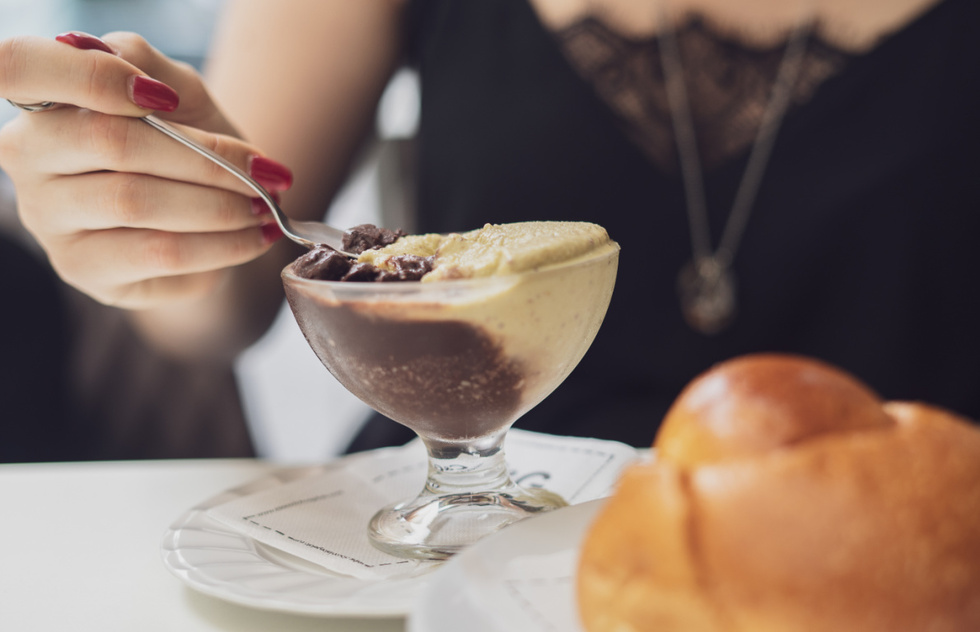 (Sicilian granita | Credit: gombru / Shutterstock)
(Sicilian granita | Credit: gombru / Shutterstock)
By the Glass
Sip Marsala at the source. The port town of Marsala has been on the international wine map since British sailors developed a taste for the locally made fortified sweet wine in the 18th century. Sample the wares in the tasting rooms of the venerable Cantine Florio winery.
Taste the OJ in Palagonia. Blood oranges have been harvested in Sicily since 9th-century Arabs planted orchards in the fertile valleys of the Conca d’Oro region. The fruit yields deliciously refreshing juice that flows like water in the orange-growing town of Palagonia, especially during the late April orange festival.
Cool off with a granita. This summertime favorite made with shaved ice and fruit juice, or sometimes a shot of espresso, has been helping Sicilians beat the heat for centuries. In Catania, the island’s granita capital, vendors used to cart the ice down from nearby Mount Etna. The long-standing Caffè Europa on Corso Italia is the best place to enjoy this refreshing treat.
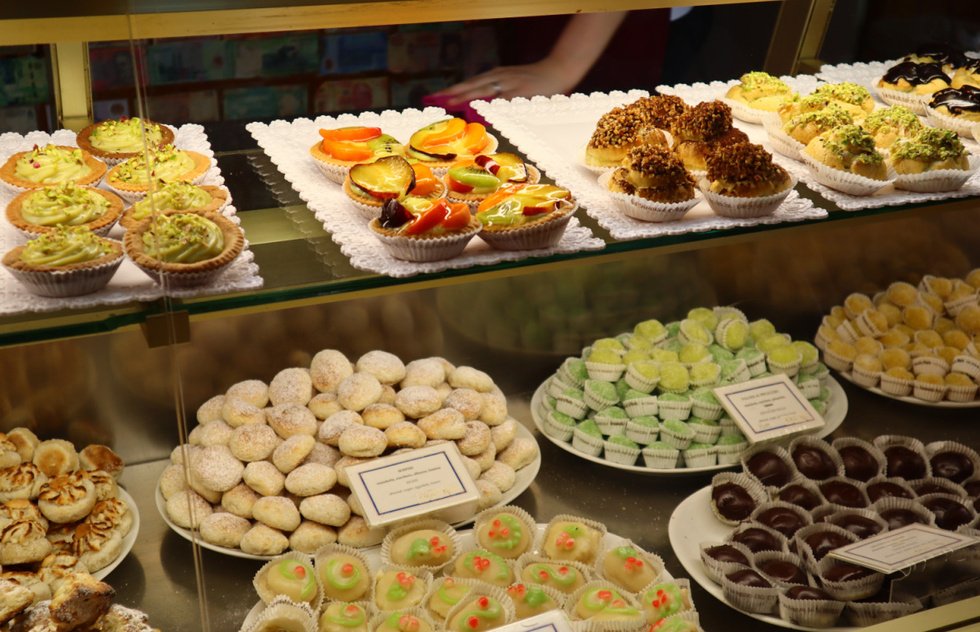 (Display case at Maria Grammatico bakery in Erice, Sicily | Credit: Walter Cicchetti / Shutterstock)
(Display case at Maria Grammatico bakery in Erice, Sicily | Credit: Walter Cicchetti / Shutterstock)
Desserts and Pastries
Indulge in sinful pastries devised by convents. Out of the ovens at I Segreti del Chiostro, set off a peaceful cloisters hidden high above Palermo’s beautiful Piazza Bellini, come decadent concoctions based on recipes gathered from convent bakeries throughout the island. Try a classic Sicilian cassata, a liqueur-drenched cake in a marzipan shell.
Breakfast on a brioche at Caffè Sicilia. At this 125-year-old Noto institution, a sweet roll is filled with a few scoops of sorbetto, made in house from fresh figs, berries, and other local bounty. Still hungry? Try what might be the island’s best cannoli.
Treat your sweet tooth at La Pasticceria di Maria Grammatico in Erice. Owner Maria Grammatico learned her craft in a local convent orphanage and is world-famous for her paste di mandorla (almond-paste cookies) and frutta martorana (marzipan shaped into fruits so realistic they look like they’ve just been picked).
Give into your chocolate craving in Modica. Sicily’s chocolate capital is a baroque beauty of a town climbing the sides of a deep gorge. Chocolatiers at Sabadì and other shops follow 400-year-old methods introduced by the island’s Spanish rulers to produce a granular, cacao-rich product, often infused with cinnamon and pepper.
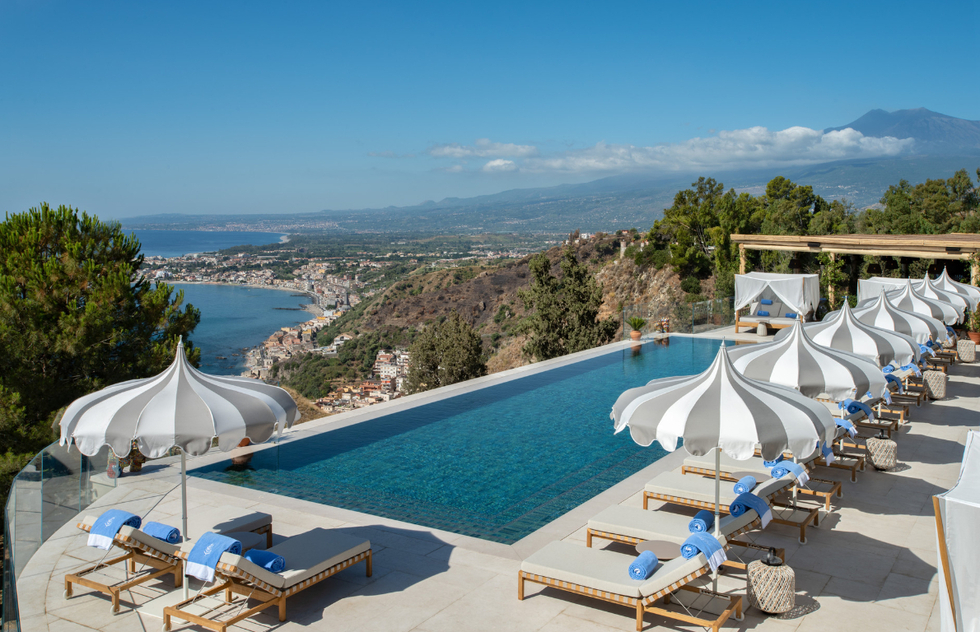 (Pool at San Domenico Palace, Taormina, a Four Seasons Hotel in Sicily | Credit: Peter Vitale / Four Seasons)
(Pool at San Domenico Palace, Taormina, a Four Seasons Hotel in Sicily | Credit: Peter Vitale / Four Seasons)
Stylish Stays
Hide away in Henry’s House. A seaside mansion turned hotel on Ortygia Island in Syracuse is awash in colorful floor tiles and antiques. The ambience, intimate flower-filled terraces, and warm hospitality will make you feel like you’re staying in the home of a Sicilian relative.
Wake up to a view of a Greek temple. Windows at the 17th-century Villa Athena, restored as a posh hotel, frame the spectacle of Agrigento’s Valley of the Temples; the time-worn columns and pediments seem to be within touching distance. Even if you’re not checking in, you can savor the same views over a drink on the bar terrace.
Decompress at Scicli Albergo Diffuso. These accommodations with full hotel services are tucked away in old houses scattered throughout the historic center of a southeastern town that’s far enough off the tourist trail to deliver an authentic Sicilian experience. Unlike many Airbnb hosts, staff members are stationed just down the street in a reception lounge and bar. They’ll even make breakfast for you.
Plop down in a palace. The Duchess of Palma accommodates guests in her gracious Butera 28 short-stay apartments on the Palermo seafront. It’s no accident the premises suggest an old-world aristocratic lifestyle: This was the final home of Giuseppe Tomasi, Prince of Lampedusa, author of the modern Italian classic The Leopard (1958).





